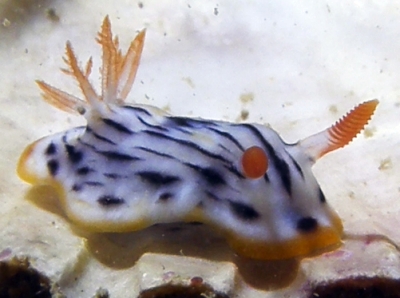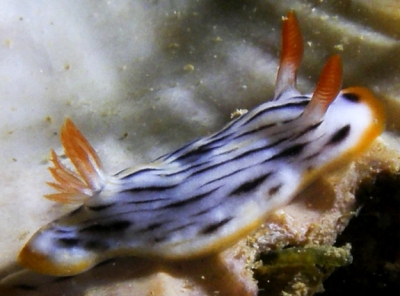Re: Another Chromodoris striatella? from Indonesia
July 25, 2008
From: Jean-François Hervé


Concerning message #19347:
Dear Bill,
I just received these two photos and I wonder whether they could not help us to differentiate Chromodoris burni and Chromodoris striatella?
It seems to be a Hypselodoris maritima without the blue margin. Perhaps it's the real C. burni? I'm lost.
Locality: Noumea, 10 m, New Caledonia, Pacific ocean, 14 july 2008, muddy. Length: 2 cm. Photographer: Yves Gillet.
Thank you for your help.
Jean-François Hervé
jfherve@free.fr
Hervé, J-F., 2008 (Jul 25) Re: Another Chromodoris striatella? from Indonesia. [Message in] Sea Slug Forum. Australian Museum, Sydney. Available from http://www.seaslugforum.net/find/21702
Dear Jean-François,
In this line of study, being 'lost' can be both frustrating and exciting, because it means there are still interesting things to discover. And knowing you are lost is much better than thinking you know it all! We still have a lot of work to do on these black-lined chromodorids, and every time I see a new 'colour variant' like this I suspect we need to do quite a bit more collecting and surveying before we can sort them all out.
Your message sent me back to look at Chris Cowley's earlier messages [#19347, #19348] and your earlier message [#19123] of animals I identified as C. striatella, and Gary Cobb's message [#11159] of an animal I considered to be C. burni. I also had another look at a species Risbec (1928) described from New Caledonia as Chromodoris clavata. I have included a painting published by Risbec (1928: Plate 7, fig.2) alongside. When I published on this group of chromodorids (Rudman, 1982), I considered on anatomical and colour pattern grounds that C. clavata was a synonym of C. striatella. Risbec described the rhinophores as red and the gills as edged in red. There is no doubt that the animals in your earlier message [#19123] are the same as Risbec's C. clavata. Which I guess raises the question of whether C. clavata and C. striatella are the same species or not?
Externally, multiple black lines on the mantle, reddish gills and rhinophores with white spots, and a pattern of 5 blackish smudges on the back have all characterised C. striatella. I won't confuse the discussion by including C. lineolata, other than to say that in that species we can describe the colour pattern as white lines on a black background. Returning to C. striatella and C. clavata, the major external difference was the broad space near the mantle edge in C. clavata which lacked black lines. While not clear from Risbec's descriptions, another difference is that in C. clavata the gills and rhinophores lack the white spots of C. striatella, and the gills have black lines edging the basal part of the gills and orange edging further up. This can be seen very clearly in your earlier message [#19123].
My first thoughts were that C. clavata and C. striatella are indeed different species, as colour differences like this are not usually found in the same species in the chromodorids, but then I noticed in the middle photo of your message #19123 that the tips of the gills in the lower animal are starting to branch and are becoming translucent orange. Also if you look at Chris Cowley's two animals from Indonesia [#19347, #19348] the one in message #19347 seems to be developing gills like a typical C. striatella as in message #19348. And in Brian Darvell's Hong Kong photos [#6065] a typical C. striatella has traces of a black line on its spotted gills.
Which brings me to your animal. I think it is a juvenile of 'C. clavata'. I know the 5 black patches aren't present, but I presume they develop as the animal grows in size. The orange-edged gills are interesting because they have indications that they are developing branches near the tips, which is what you find in typical C. striatella. It seems that C. clavata is a colour form or perhaps a growth stage in C. striatella in which the gills and rhinophores have yet to develop their white spots.
Which brings me to Chromodoris burni. When I described that species I considered the black and orange lines on the gills, and the absence of 5 black patches to be of importance, but if what I say above proves correct then I am afraid C. burni is most probably a synonym of C. striatella as well. Gary Cobb's message [#11159] shows an animal which could be considered halfway between typical C. burni and C. clavata because it has a band around the mantle edge lacking fine black lines.
I hope this all makes sense. Basically I think your photo has given me a clue to the relationsips of these various colour forms. It looks to me as though the unspotted gills and rhinophores represent a juvenile or growth stage in the dvelopment of C. striatella, and if so, C. clavata should remain a synonym of that species and C. burni may have to become one.
Best wishes,
Bill Rudman
Related messages
-
Another Chromodoris striatella? from Indonesia
From: Chris Crowley, June 15, 2007 -
Chromodoris striatella from Flores Is., Indonesia
From: Chris Crowley, June 15, 2007 -
Egg ribbon of Chromodoris striatella
From: Bill Rudman, January 29, 2007 -
Chromodoris striatella egg-laying
From: Jean-François Hervé, January 8, 2007 -
Chromodoris striatella from sthn Queensland
From: Gary Cobb, September 30, 2003 -
Chromodoris striatella with some spots
From: Roberto Sozzani, May 14, 2003 -
Chromodoris striatella from the Philippines
From: Erwin Koehler, April 3, 2003 -
Chromodoris striatella - feeding
From: Bill Rudman, April 3, 2003 -
Chromodoris striatella from SE Australia
From: David & Leanne Atkinson, January 27, 2003 -
Chromodoris striatella from Hong Kong
From: Bill Rudman & Brian Darvell, January 26, 2002 -
Colour form of Chromodoris striatella
From: D.& L. Atkinson, May 17, 2000 -
Chromodoris striatella? from Japan
From: Rie Nakano, June 19, 1999
